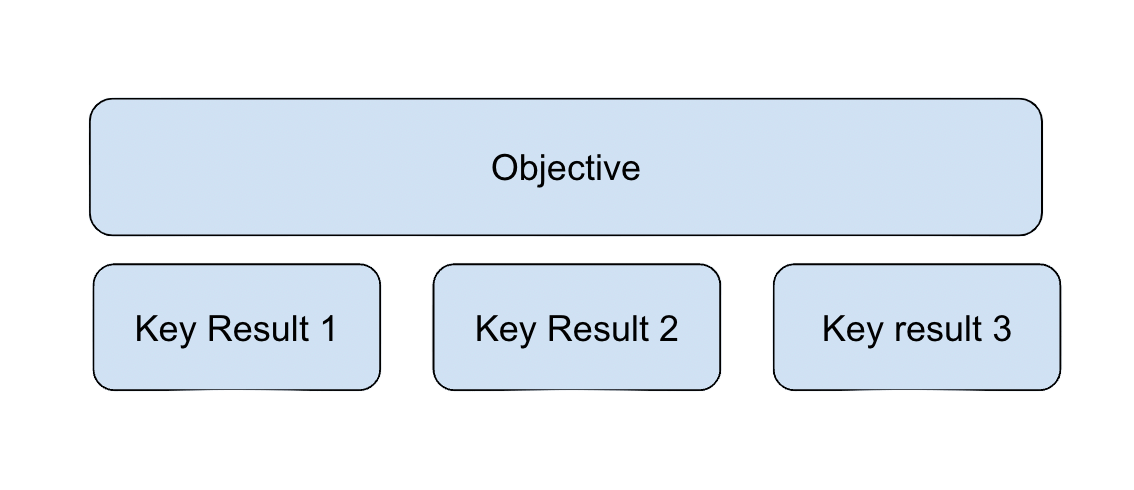Typically, SEO managers don’t have the authority to introduce OKRs within their organizations. However, after working with this system for over a year, I discovered that it is a great tool to measure SEO progress and get actions implemented. It gives visibility to stakeholders on how SEO is doing and highlights occurring problems. Nevertheless, it’s not very easy to dominate. Especially, considering that SEO is a complex subject with long-term effects. That is why I’m eager to share my insights on applying OKRs to SEO and reaping the benefits of this approach.
What Are OKRs?
Being brief, OKRs (Objectives and Key Results) is a goal-setting framework. It helps teams to define priorities for the next quarter (or another period of time) and align them throughout the company. The methodology was first created by Andrew Grove in Intel. Since then, it has been adopted by a lot of big and small companies, including Google, Amazon, Disney.
OKRs consist of two parts:
Objective – ambitious, but attainable, business goal that the company (team / individual) wants to achieve.
Key Results: 3 to 5 metrics used to measure the progress towards the goal.

In the context of SEO, an objective could be:
Increase organic visits by improving the website SEO performance
Its achievement could be measured, for example, by the following key results:
- Average number of inlinks per landing page
- Average crawl depth of landing pages
- Non-brand CTR
There are several types of OKRs:
- Committed: something you have to achieve
- Aspirational: something ambitious you would love to achieve
- Learning: something you don’t know much about and would like to investigate
Now, Let’s Talk About How To Create Appropriate OKRs For SEO
Let’s start with the objective
Objective is the ambitious goal you would like to achieve. It has to be aligned with the company guidelines, and be more important than other things you could do. It also has to be something outside your everyday responsibilities. For example, you can’t set a goal of “doing a KW research for 10 categories” if that’s part of your BAU.
Don’t forget about the outcome
On the other hand, the objective shouldn’t be too broad. So you can’t define it as “Do more SEO” or “Content Strategy”. Your OKR should point to some outcome.
Here are some examples of SEO objectives:
- Increase organic traffic in long term by focusing on SEO technical health
- Improve SEO performance by optimizing on-page content
- Enhance Local SEO Presence
- Enhance User Experience for SEO
Now let’s get to the Key Results
After defining the objective and before putting down the Key Results, it’s important to think of the initiatives you would like to carry out. Let’s imagine that your objective is to “get more organic visits by improving website SEO” and the main opportunities lie in link building, optimization of titles / meta-descriptions and search intent.
In this case, the Key results could be the following:
- “Get 100 backlinks”
- “Improve average CTR by 10% for the top-20 URLs”
- “Reduce bounce rate on the top-10 pages by 20%”
On the other hand, if the biggest win is optimizing the website architecture, you would possibly want to focus on:
- Crawl depth for category pages
- % of duplicate content
- Number of inlinks per category page
What a good key result looks like
As I already mentioned, the key results are a way to measure the progress on the objective. They should be:
- Transparently calculated. Anyone should have visibility on how the metric is measured and be able to reproduce the process. The values should not depend on the interpretation.
- Have a clear deadline. It could be end of the quarter / year etc.
- Impactable. You should try to find metrics that are not impacted by something outside your control. For example, organic traffic has too many outside influences to be an actionable KR.
- Moderately ambitious to keep the team motivated
Also, the KRs could be qualitative or quantitative
- Qualitative -> for example, improve pagespeed
- Quantitative -> launch 100 new landing pages
It’s better to balance out the quantity KRs with the quality ones. This way you could avoid “tunnel-vision” when you concentrate on achieving one metric and sacrifice another one.
Following this pattern, the SEO OKRs could be the following:
O: Achieve more organic visits by focusing on the on-page SEO
KR1: Launch 20 landing pages (quantity)
KR2: Reduce number of duplicate pages by 20% (quality)
KR3: Reduce SEO bounce rate by 5% (quality)

Important!
Objective is something that gets measured by the key results. It means that achieving the KRs you set, should automatically mean the completion of the objective.
So let’s imagine you set an objective to get 20% YoY growth in SEO and later measure it by achieving 50 backlinks, optimizing KWs positions and pagespeed. Even though you can move all of those metrics towards planned results, it will not guarantee 20% growth in traffic.
So it’s important to define an objective that can be “guaranteed” by the Key Results. In our example we can either:
- Redefine the objective
- Change the KRs to : “improve XX section organic traffic by 10%”, “improve blog traffic by 20%”, “reduce website organic bounce rate by 10%”
However, when was the last time everything went as planned in SEO? With the constant trend changes, algorithm updates and competitor actions, it’s almost never possible to guarantee a certain growth percentage.
So I personally would try to avoid objectives like “+XX% organic traffic growth YoY” or “Outranking a competitor”.
Tracking OKRs: What Comes Next After Commitment?
After the OKR has been set, the work begins. The team (or individual if it’s a personal OKR) starts implemented the defined initiatives and reporting on the progress made.
Normally, OKRs are set either annually or quarterly. The annual ones get tracked every month and quarterly ones – every week.
There are three basic states for every KR:
- If the key result is on track, it’s green. Keep doing what you’re doing!
- If it’s “in danger” it goes to yellow. The team has to discuss how to change the strategy to get it back on track
- If the KR is blocked or can’t be achieved, it goes to red. The team has to decide if it wants to do more “push” or drop the KR and focus on other things.

Benefits of OKRs
If done correctly, OKRs could have many benefits:
- Clear priorities and alignment of resources
- Transparency and fast detection of problems
- Commitment to the goals
- Collaboration between teams
- Motivation to achieve greater things
At the end, I would like to highlight that OKRs is a flexible framework that can be customized to fit any company’s needs. So, I hope this article has been helpful, but remember to consider the project specifics while setting your own objectives and key results.
Daria Miroshnichenko
Note: this article contains only my personal research and opinion:)
Sources and recommended literature:
J. Doerr - “Measure What Matters: The Simple Idea that Drives 10x Growth”

